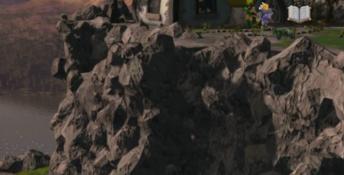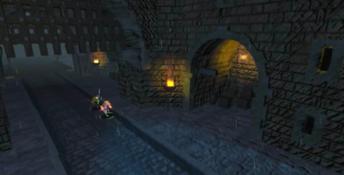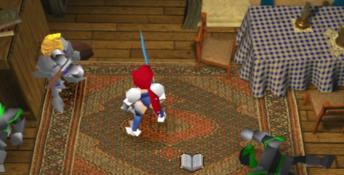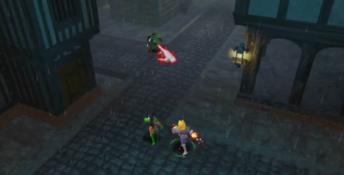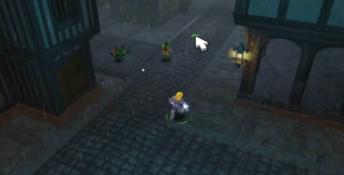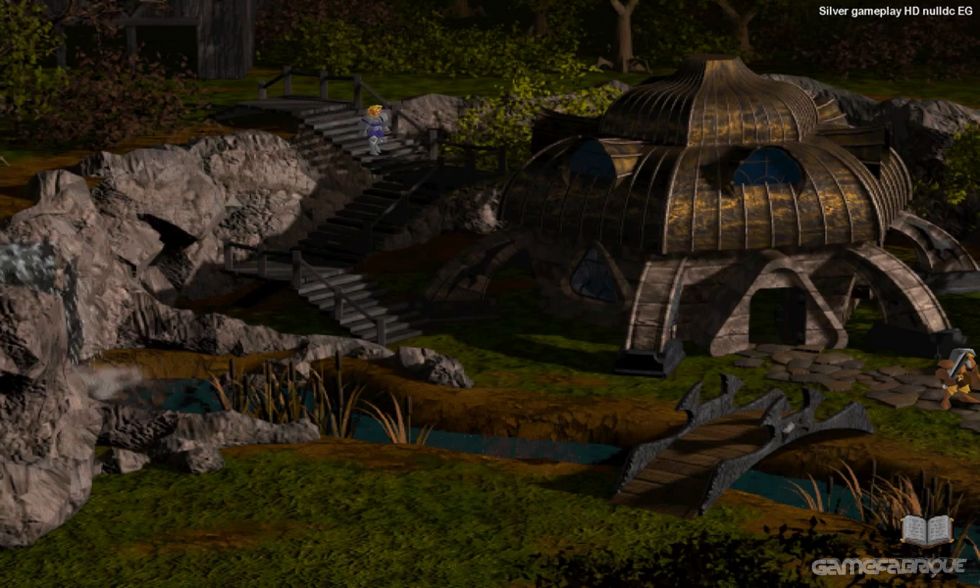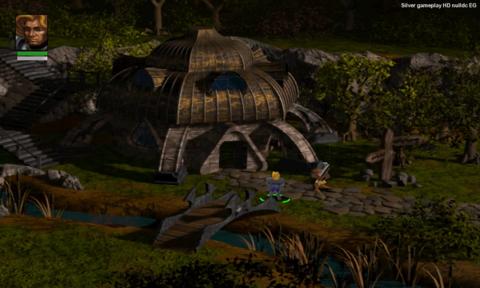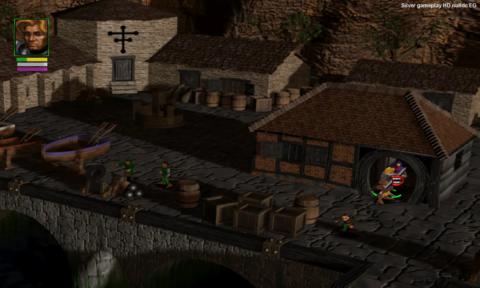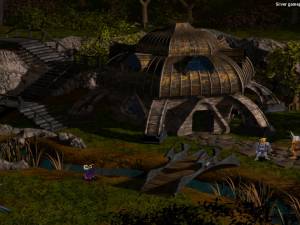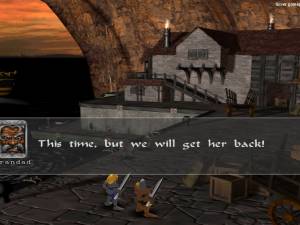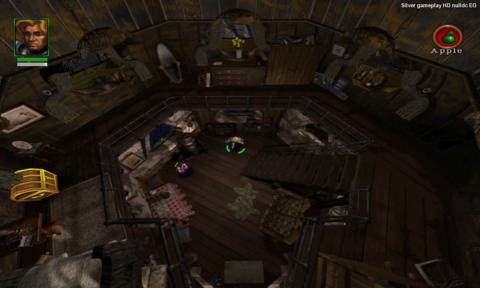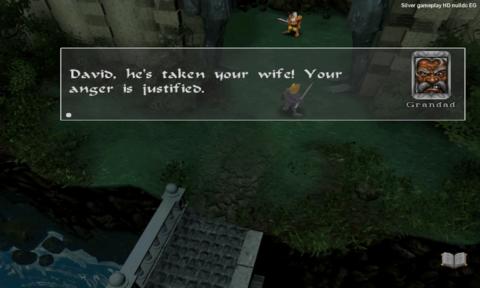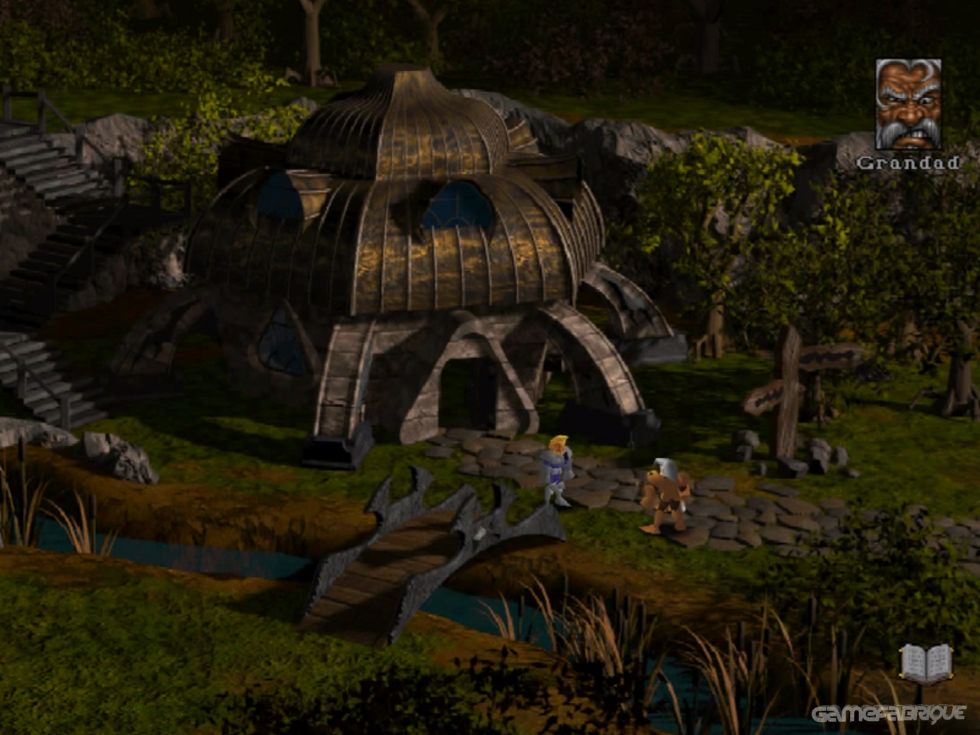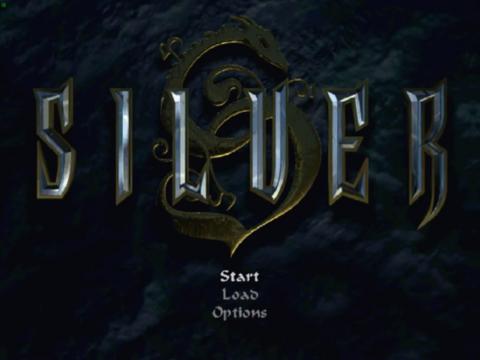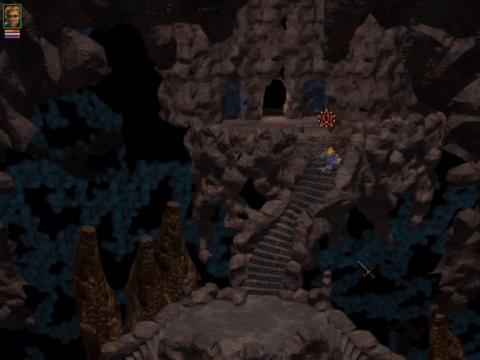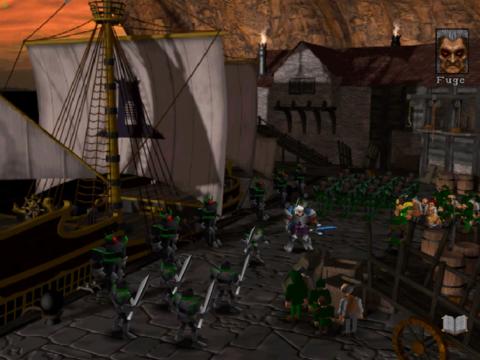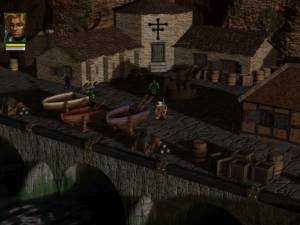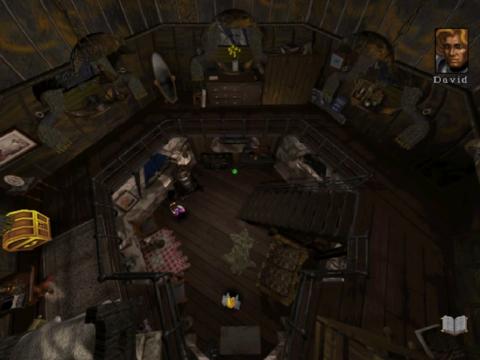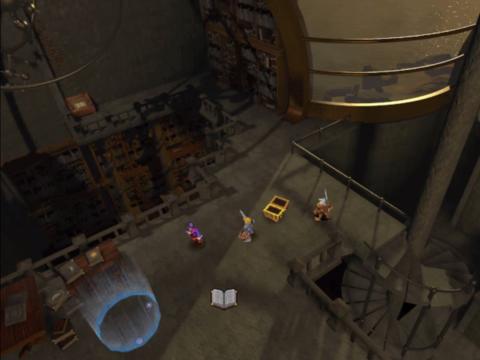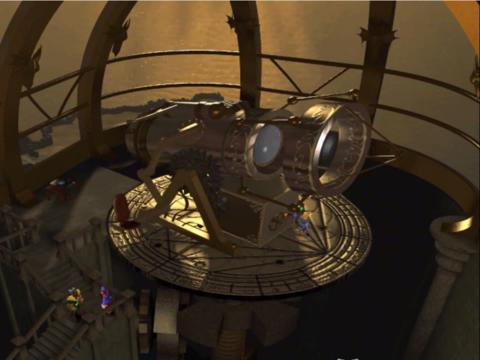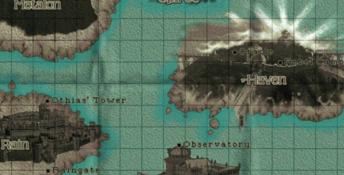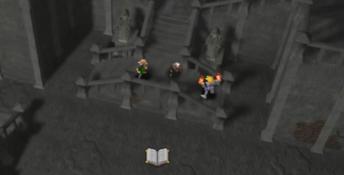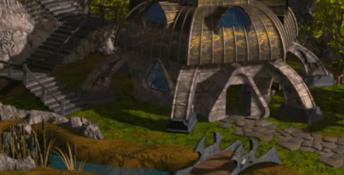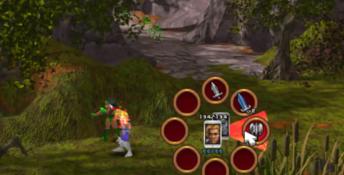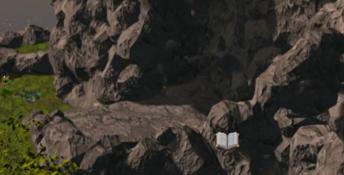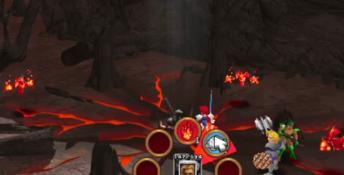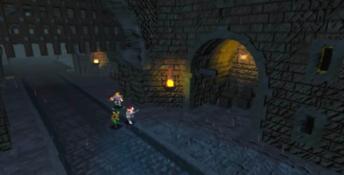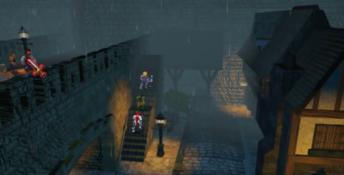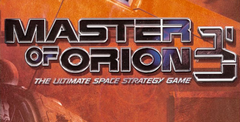Silver

| a game by | Infogrames |
| Platforms: | Dreamcast, PC |
| Editor Rating: | 5.7/10, based on 3 reviews |
| User Rating: | 9.2/10 - 5 votes |
| Rate this game: | |
| See also: | RPGs |
Silver was one of those games that was in development forever. Originally a project for Ocean Software (remember them?) in the U.K., the game eventually came out on the PC through Infogrames last year. Despite the build-up and the hype, it was met with a lukewarm reception on the PC thanks to its "console-like" RPG sensibilities. That'll do nicely for the Dreamcast then, thank you. Set in a traditional knights, big swords and monsters environment, the game should be with us this summer.
Download Silver

System requirements:
- PC compatible
- Operating systems: Windows 10/Windows 8/Windows 7/2000/Vista/WinXP

System requirements:
- PC compatible
- Operating systems: Windows 10/Windows 8/Windows 7/2000/Vista/WinXP
Game Reviews
Overview
The evil sorcerer, Silver, has entered a pact with the god Apocalypse. As part of this pact, Silver, his warrior son Fuge, and their followers have abducted all of the women in the land of Jarrah. One of these women is your wife, Jennifer, and now it is up to you, David, to rescue her and everyone else that was kidnapped. Basically, it’s your standard "rescue-the-helpless-women" type theme.
Gameplay, Controls, Interface
After you get past the long intro at the beginning, you will be introduced to some of the basic moves in the game and get to practice them for a minute or two until Fuge shows up to take Jennifer. That’s where the "online tutorial" ends. To learn the rest of the controls, you need to read through the manual. As you progress, you will pick up a ton of items that are all accessible in the Pie Menu. Now the Pie Menu is handled a bit differently from other games in that it all branches out from a central hub and is compromised of pictures rather than text. When something is highlighted, you can see what it might be and select accordingly. I found that it took me a few times playing before I became more comfortable with the menus, but I also found that some items weren’t where I expected them to be. For instance, weapons that have projectiles (such as crossbows) are in a different menu from swords. The manual does go over this and the rest of the interface is pretty self-explanatory.
Moving around and using items ranges from very simple to somewhat complicated. As all good games should, you have your basic hack and slash moves. There are also more specialized attacks and defense moves that take a little more talent to pull off. For instance, to do a powerful lunge, you need to hold the right trigger while pressing up on the control pad or joystick. Now while these moves are fairly easy to remember, I found myself frequently executing the wrong one since a person may not be above me on screen, but to the right. Like I said, you need to develop a knack for these. Once you have, you’ll be much stronger in battle.
One nice thing about this setup is that while there are complicated moves you CAN learn, you don’t HAVE to be frustrated by the game if you have problems -- just hack and slash! There are some other moves that I simply could not understand no matter how many times I read the manual and/or practiced them. These were moves that allow you to use magical devices. I found that many times the move simply would not execute and other times it would. Naturally you need to have these types of weapons charged before use but I had problems determining if it was ever charged to begin with. Aside from either my or the game’s shortcomings on the magical stuff (probably mine, but hey, whatever happened to simple controls?), the general control is quite responsive. There’s another interesting aspect to the control -- if you hold the left trigger down, it will show any items that can be picked up, people that can be talked to, and exits that you can use to leave the room. You can select one and your character will then walk to it to interact. I found this to be fairly useful in some rooms where it seemed there could be something else -- if there was, I was able to find it easy enough.
Silver takes an interesting perspective in terms of how the game plays. There is no "camera" of sorts that follows you around like so many of today’s games. Rather, the camera stays stationary on a particular screen and may scroll with the background as needed. This approach has both its advantages and disadvantages. The advantage to this is since you can see everything that is going on around your characters, you can more or less plan how you want to take on the current onslaught of enemies. The problem is that since the game is trying to take on a 3D perspective, as you move further away from the camera, your characters will get very small. Sometimes they get so small that it’s difficult to even see which way they’re facing. Mind you, I was playing this on a 27" TV so it shouldn’t have been this bad. I found that many of the battles I had were in the farther back part of the screen as opposed to right up front. Because of this poor perspective, I found myself getting hit much more than normal. On the plus side, virtually everyone you kill will drop some type of food (which will restore your life). Another plus to this is that there are frequent save points along the way. Once you talk to The Chronicler (the save point person), he will disappear and you can no longer save at that point. You don’t have to talk to The Chronicler as soon as you see one, though.
Silver contains most of the goodies you’d expect to find in a good RPG style game. You have fighting, puzzles, a big cast of characters to interact with (or as), lots of items that you can find or buy, and of course, boss characters. Really about the only thing missing is that you don’t have to build up attribute points at all, which is something I didn’t miss one bit.
Graphics
This game is visually stunning. I was initially impressed by the screenshots on the game’s jewel case and when I saw these on the TV, they were that much better. The backgrounds are very detailed and lifelike. The individual characters look very nice close-up, but since the game has an element of 3D to it, many times the characters are just a couple of small dots in the distance. The various effects such as fireballs or glowing magical items look really nice too.
Audio
The music is quite fitting for this style of game and really helps set the ambience well. The quality is pretty standard for a Dreamcast game. The voices are clear and understandable which is really nice since the entire dialog in the game is spoken (there’s an option for text too). Some of the voices seem a little bizarre, such as one of the merchants who sounds like someone making a very bad attempt at an English accent.
Documentation
Well, there’s a lot there that needs to be read. While the game will go over the basics with you at the beginning, it’s up to you to learn the rest by reading the manual. I had problems utilizing several of the controls in the manner listed in the manual. I would highly recommend keeping this around until you fully understand how to control the game because it’s very likely you’ll need to refer to it time and time again before you’ll know how to do everything David can do.
Bottom Line
I had mixed feelings about this game. It’s almost a great game, but falls short in a couple of places -- particularly how the characters get way too small when they move further away from the screen. The storyline is so-so, nothing real new or exciting here. Most of the control is very responsive and several levels of complication may make this game more appealing to all levels of RPG players. The graphics look great and are definitely a plus. I felt this game has some interesting innovations such as being able to see all the interactive items in an area. I would recommend Silver to everyone who enjoys playing a good RPG but likely no one else, as there are a lot of times when dialog reigns over actual gameplay. I’m sure many RPG players will be able to see past what I consider shortcomings, however I still did have some minor troubles which is why I give this game a score of 82.
Overview
About nine years ago I found myself, for the first time, downright addicted to a role-playing game. The game was Final Fantasy and I spent 27 straight hours on my now lowly NES before I passed out from exhaustion. Upon waking and cross-referencing my progress against the Nintendo Power strategy guide, I determined I was only a little over a third of the way there. What followed made the first 27 hours seem like a cakewalk. I still shudder over the deliriums I experienced trying to clear one more area. Since that time, I have been on a search for a game which would capture that same excitement for me. It had to feature an engrossing story, addictive character development, and turn-based combat (all the more manageable when you are on your third half-rack of diet cola). Upon first glance, I thought Infogrames' Silver was next in line... but I was a little off my mark.
Silver is Infogrames' foray into the Adventure/RPG genre which is getting popular these days. Additionally, Infogrames throws a little (actually more than I’d like) real-time strategy into the combat sequences. I guess you could call this one of the first Adventure/RPG/RTS titles.
You are David, young adventurer and devoted husband to Jennifer. You live in Jarrah where the token scary-guy is an evil sorcerer named Silver. He not only is the meanest dude around, but you and the other citizens doubly benefit from him being the guy "in charge." So what's a bald, ugly, and evil sorcerer to do shortly after strangling his wife for sleeping with his right-hand man? That's right, send his son all over the world in a big boat to scoop up all the women. Silver needs a new bride after all. What a great guy... must not be up for re-election, eh?
You can imagine what happens to your own wife Jennifer. Now you and your grandfather must set out to find her as the adventure unfolds.
Gameplay, Controls, Interface
Initially Silver starts out with the traditional adventure gaming feel. You move through pre-rendered (almost seemingly 3D) scenes, chat with characters, engage in a little combat (actually a lot), and basically move the storyline along. Even though it’s mostly linear in the way you’re led through each act, you will tend to enjoy what’s around the next corner... even if it is the only corner in the story.
Controlling David is a simple enough matter -- you click where you’d like him to go and he goes. Other characters in your party follow you around pretty well. You can choose to switch primary control over to another character by clicking on him or her (or by using hotkeys). This is helpful when setting your characters up for an ensuing battle.
Combat is handled with a mixture of the buttons and movements of the mouse while holding down the control key. Each combination brings about a different combat move. Luckily you will spend time with your grandfather at the onset to help learn the basics. Ranged combat (with projectile weapons) works easily, as well. Well, it is easy if we’re just talking about you and your grandfather, but more on that later.
A simple right click of the mouse brings up the "Pie Menu." If you have ever played LucasArt’s Full Throttle, it is very similar to that control scheme. This menu is where you control the equipping of your characters and have access to inventory items, spells, weapons, etc. It is quite intuitive right from the get go.
The "role-playing" aspect of Silver is pretty simplistic in nature. You have two bars that measure your health and magic. Get hurt, eat some food or drink a potion. Find a new sword? Equip yourself using the pie menu. Need to choose between special moves? Same menu. Level increases seem to only happen after each foozle is eliminated at the end of each act. Simple stuff. Hardcore role-players should look elsewhere, as most wouldn’t consider Silver anything close to a true RPG. I, on the other hand, enjoyed not having to worry too much about the intricate details on the make-up of my characters.
So take all this and wrap a pretty intriguing storyline around it and you must have a great game right? Well, that’s what I thought most of the way through the first part of the game. It’s after you start having folks in your party (other than your grandfather) that you see the one true weakness within Silver.
I can best describe combat with more than one character in your control as a poor real-time strategy game hidden within a great adventure game -- at least that is the feel of it. You will be lulled into false comfort by how well your grandfather handles himself during the first act. You will rarely have to manage his actions at all. It’s only at the start of the next act (where you are paired with another character) that the awkwardness of the control comes to a head. There is literally nothing you can do to get the additional help to actually help -- most of the time they just stand there and watch the main character take the brunt of the abuse. Often you are left clicking on each character, selecting a target, and telling them to go at it. By the time you are done, the other characters have forgotten what they were doing and you must do it all over again. It reminded me a lot of playing the first Warcraft, while requiring the hand-eye coordination of ping-pong. Additionally, some of the camera angles in these scenes inhibit you from successfully pulling any of this off. Often I would have to lure the baddie out in the open so I could maneuver myself correctly to succeed.
This wouldn’t be so bad, but Silver contains a lot of these combat sequences -- a whole heck of a lot. I wouldn’t call it totally bad, but when you are trying to get all your characters to stay alive and to banish the bad guys at the same time, well, tedious is a word that quickly comes to mind.
If Infogrames had chosen to implement a turn-based combat option, I would have been fine. The micro-management strategy that needs to be mastered to progress through the game really turned me off here.
Graphics
Stunning.
Can I use "stunning" without sounding over the top? The pre-rendered backgrounds that make up the world of Jarrah are sometimes breathtaking. It is obvious that a lot of work and care went into creating these scenes. Additionally, it would appear that each location was rendered from a different viewpoint adding to the visual style. While sometimes this can get confusing, it does serve to move away from standard set backgrounds that similar games have used. Little pockets of animation liven these shots up even more. Whether it is a seagull soaring overhead or a rain-pelted street lit by flashes of lightning, it's a wonder to behold.
The character animations are quite a bit different. Almost (maybe deliberately) anime-like, the characters are bright, colorful, and full of sharp edges. Where the backgrounds are almost works of art, the low polygon count of the characters seems to be out of place. Don't get me wrong, they aren't too terrible (imagine Alone in the Dark mixed with Ecstatica); they just don't seem to fit into the world in which they live. The low polygon count does allow them to move fluidly, and even on low-end machines a screen full of animated characters is quite lively and smooth.
Both of these different "styles" serve the story nicely. Silver presents a rich graphical environment without requiring you to have a beast of a machine to enjoy it.
Audio
It's not often that a game gets the musical score, environmental audio, and voice-acting all to exist in the same title without one of them being the brunt of the jokes. It's almost a die-hard rule that if the game has a great soundtrack, you had better stick with a text-based storyline, because there is no way they can pull together the actors to do it justice. Or maybe they'll pull off some amazing voice-overs only to have the producer's nephew provide the background music on his recorder from 7th-grade band.
Silver, on the other hand, surprised me here. Everything fits. The acting is quite good although some characters are a little over the top. The music sits in the background nicely and you can actually rely on the environmental sounds to set the mood of a scene. It's clear that someone worked as hard on the audio mixing and the gathering of vocal talent as they did on the graphics.
System Requirements
Minimum: Pentium 166, 32 MB RAM, 2 MB video
Recommended: Pentium 233, 32 MB RAM, 4 MB video
Hey, here is a game that DOESN'T feature 3D acceleration and still looks great. Imagine that!
Documentation
A game like this must have a manual detailing the great story, right?
Er...
Silver features the all-too-familiar jewel-case tome that attempts to explain the game's ins and outs. Since they are restricted to the number of pages that can comfortably slide into the cover, it leaves little hope of actually giving the player a great pre-game story and the detail needed to succeed in that story.
Silver does such a great job in telling the story within the game, it's forgivable that the 20-page booklet spends most of the wealth in teaching you the interface. This is actually quite needed given the difficulty you will face when controlling more than one character who isn't your grandfather.
Bottom Line
So we have a game before us that has a lot going for it -- excellent visuals, superb audio, and an engrossing storyline. We have three attributes that usually make a great game, but we have a game that tries to be three different games as well. It has the adventure and limited role-playing aspects down okay; it's the excruciating combat sequences that often killed my mood.
The wacky character control, the real-time strategy feel (confusing in a game of this type), and the almost arcade-reflex skills needed to progress through the story contributed to my disappointment. Additionally, since the amount of time spent in combat is so large compared to "adventuring," this shortcoming becomes frustrating. If only they had included the option of turn-based combat (ala Final Fantasy), I would have heralded this as one of the better plays of the year...
...but alas, my search goes on.

